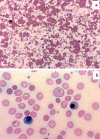The Clinical Pictures of Autoimmune Hemolytic Anemia
- PMID: 26696800
- PMCID: PMC4678314
- DOI: 10.1159/000440656
The Clinical Pictures of Autoimmune Hemolytic Anemia
Abstract
Autoimmune hemolytic anemia is characterized by shortened red blood cell survival and a positive Coombs test. The responsible autoantibodies may be either warm reactive or cold reactive. The rate of hemolysis and the severity of the anemia may vary from mild to severe and life-threatening. Diagnosis is made in the laboratory by the findings of anemia, reticulocytosis, a positive Coombs test, and specific serologic tests. The prognosis is generally good but renal failure and death sometimes occur, especially in cases mediated by drugs.
Keywords: Agglutinin; Autoimmunity; Direct antiglobulin test; Hemolysin; Hemolysis.
Figures



References
-
- Packman CH. Hemolytic anemia resulting from immune injury; in Kaushansky K, Lichtman MA, Prchal JT, Levi MM, Press OW, Burns LJ, Caligiuri MA (eds): Williams Hematology, 9th ed. New York, McGraw-Hill, chapter 54, 2016 (in press).
-
- Dacie JV. The Haemolytic Anaemias, vol 3, The Autoimmune Haemolytic Anaemias, 3rd ed. New York, Churchill Livingstone, 1992.
-
- Petz LD, Garratty G. Acquired Immune Hemolytic Anemias. Philadelphia, Churchill Livingstone, 2004.
-
- Mayer B, Yürek S, Kiesewetter H, Salama A. Mixed‐type autoimmune hemolytic anemia: differential diagnosis and a critical review of reported cases. Transfusion. 2008;48:2229–2234. - PubMed
Publication types
LinkOut - more resources
Full Text Sources
Other Literature Sources
Medical

